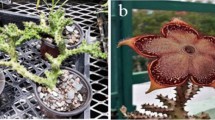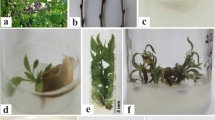Abstract
Roses are an important commercial crop available in a wide range of varieties in international markets. Due to its economic value, this study aimed to establish a new and reproducible protocol for the in vitro propagation of Rosa damascena Mill. We developed an efficient and cost-effective method for rapid and high-quality shoot multiplication and in vitro rooting of Damask rose using nodal explants. For each stage of the micropropagation procedure (i.e., explant establishment, shoot multiplication and growth, and rooting), different media and combinations of plant growth regulators were utilized. A new culture medium, termed A19, resulted in significant improvements to shoot proliferation and root induction for this rose cultivar. For optimal explant establishment, shoot growth, and proliferation, a modified Murashige and Skoog medium with higher levels of nitrates, calcium, and iron plus supplementation with 4 mg/l 6-benzylaminopurine and 0.25 mg/l indole-3-acetic acid was utilized. To increase shoot length, 75 d after culture initiation (including two subcultures), shoots were transferred to the same medium additionally supplemented with 0.2 mg/l gibberellic acid. This resulted in vigorous shoot growth, with longer shoots and a greater number of shoots per explant. Shoots were then separated and transferred to various root induction medium for 30 d. The results clearly showed that a liquid ½A19 medium-A (i.e., with half-strength macroelements) supplemented with 0.1 mg/l indole-3-butyric-acid was the most successful medium for in vitro rooting in this cultivar. Shoots were cultured in this medium for 7 d in the dark, before transfer to liquid ½A19 medium-A without hormone supplementation under a 16-h photoperiod. This modified protocol resulted in significant improvement in shoot regeneration and proliferation and obtained stronger shoots over a period of about 20 wk.



Similar content being viewed by others
References
Achuthan CR, Babu BH, Padikkala J (2003) Antioxidant and hepatoprotective effects of Rosa damascena. Pharm Biol 41:357–361
Alderson PG, McKinless J, Rice RD (1988) Rooting of cultured rose shoots. Acta Hort 226:175–182
Badzian T, Hennen GR, Fotyma-Kern J (1991) In vitro rooting of clonal propagated miniature rose cultivars. Acta Hort 289:329–330
Basim E, Basim H (2003) Antibacterial activity of Rosa damascene essential oil. Fitoterapia 74:394–396
Bordbar L (2005) Optimization of shoots proliferation for Damask rose micropropagation. MSc Thesis pp 1−80
Bressan PH, Kim YJ, Hyndman SE, Hasegawa PM, Bressan RA (1982) Factors affecting in vitro propagation of rose. J Am Soc Horti Sci 107:979–990
Curir P, Damiano C, Cosmi T (1986) In vitro propagation of some rose cultivars. Acta Hort 189:221–224
Dohare SR, Shafi M, Kaicker US (1991) Micropropagation in roses. Acta Hort 289:107–108
Douglas GC, Rutledge CB, Casey AD, Richardson DHS (1989) Micropropagation of floribunda, ground cover and miniature roses. Plant Cell Tiss Organ Cult 19:55–64
Hasegawa PM (1980) Factors affecting shoot and root initiation from cultured rose shoot tips. J Am Soc Hortic Sci 105:216–220
Horn WAH (1992) Micropropagation of rose (Rosa L.). In: Bajaj YPS (ed) Biotechnology in agriculture and forestry, vol 20: high-tech and micropropagation IV. SpringerVerlag, Germany, pp 320–342
Ibrahim AI (1994) Effect of gelling agent and activated charcoal on the growth and development of cordyline terminalis cultured in vitro. Proceedings of the first conference of ornamental horticulture 1:55–67
Jabbarzadeh Z, Khosh-Khui M (2005) Factors affecting tissue culture of Damask rose (Rosa damascena Mill.). Sci Hortic 105:475–482
Khosh-Khui M, Sink KC (1982) Rooting-enhancement of Rosa hybrida for tissue culture propagation. Sci Hortic 17:371–376
Kirichenko EB, Kuz-mina TA, Kataeva NV (1991) Factors in optimizing the multiplication of ornamental and essential oil roses in vitro. Bull Gl Bot Sada 159:61–67
Kumar A, Sood A, Palni UT, Gupta AK, Palni LMS (2001) Micropropagation of Rosa damascena Mill. from mature bushes using thidiazuron. J Hortic Sci Biotechnol 76:30–34
Mahmood N, Piacente S, Pizza C, Burke A, Khan A, Hay A (1996) The anti-HIV activity and mechanisms of action of pure compounds isolated from Rosa damascene. Biochem Biophys Res Commun 229:73–79
Murashige T, Skoog F (1962) A revised medium for rapid growth and bioassays with tobacco tissue cultures. Physiol Plant 15:473–497
Ozkan G, Sagdic O, Baydar NG, Baydar H (2004) Antioxidant and antibacterial activities of Rosa damascena flower extracts. Food Sci Technol Int 10:277–281
Pati PK, Sharma M, Sood A, Ahuja PS (2005) Micropropagation of Rosa damascena and R. bourboniana in liquid cultures. In: Hvoslef-Eide AK, Preil W (eds) Liquid systems for in vitro plant propagation. SpringerVerlag, Springer e-book, pp 373–385
Pati PK, Rath SP, Sharma M, Sood A, Ahuja PS (2006) In vitro propagation of rose—a review. Biotechnol Adv 24:94–114
Podwyszynska M, Olszewski T (1995) Influence of gelling agents on shoot multiplication and the uptake of macroelements by in vitro culture of rose, cordyline and homalomena. Sci Hortic 64:77–84
Rout GR, Debata BK, Das P (1989) In vitro mass-scale propagation of Rosa hybrida cv. Landora. Curr Sci 58:876–878
Sauer A, Walther F, Preil W (1985) Different suitability for in vitro propagation of rose cultivars. Gartenbauwissenschaft 50:133–138
Valles M, Boxus P (1987a) Micropropagation of several Rosa hybrida L. cultivars. Acta Hort 212:611–618
Valles M, Boxus P (1987b) Regeneration from Rosa callus. Acta Hort 212:691–696
Van der Salm TPM, Van der Toorn CJG, Hänisch ten Cate CH, Dubois LAM, De Vries DP, Dons HJM (1994) Importance of the iron chelate formula for micropropagation of Rosa hybrida L. ‘Moneyway’. Plant Cell Tiss Organ Cult 37:73–77
Wulster G, Sacalis J (1980) Effects of auxins and cytokinins on ethylene evolution and growth of rose callus tissue in sealed vessels. HortSci 15:736–737
Author information
Authors and Affiliations
Corresponding author
Additional information
Editor: J. Forster
Rights and permissions
About this article
Cite this article
Noodezh, H.M., Moieni, A. & Baghizadeh, A. In vitro propagation of the Damask rose (Rosa damascena Mill.). In Vitro Cell.Dev.Biol.-Plant 48, 530–538 (2012). https://doi.org/10.1007/s11627-012-9454-z
Received:
Accepted:
Published:
Issue Date:
DOI: https://doi.org/10.1007/s11627-012-9454-z




